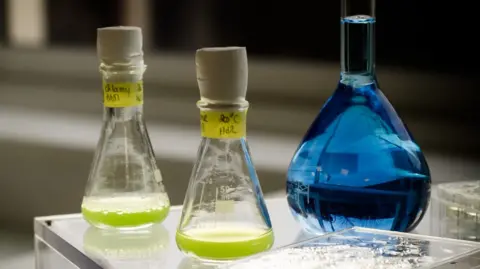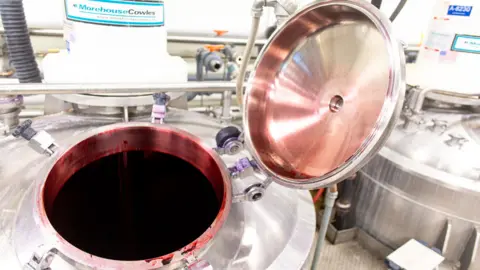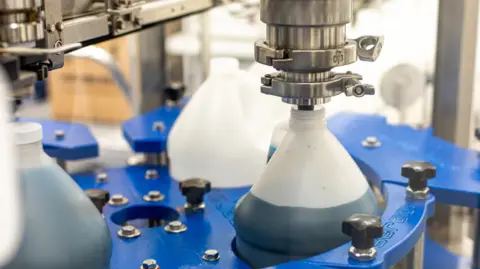JULY 25 – French agency Fermentalg has been all around the planet in its seek for helpful microalgae.
“One of our fortunate scientists bought to go and climb the volcanoes within the Caribbean for instance, and I’ve to restrain myself from amassing extra each time I am going house to New Zealand,” says Hywel Griffiths, chief scientific officer at Fermentalg.
There are a whole lot of hundreds of species of microalgae – microscopic organisms, which principally stay in water. They are important to the aquatic meals chain and likewise produce half the oxygen we breath.
Some are already used commercially, to make food, animal feed and fertiliser.
But for Fermantalg one specific kind, Galdieria sulphuraria, has a really helpful trait. It can be utilized to supply a pigment, appropriate to be used in meals, known as Galdieria blue.
“We develop the algae and make quite a lot of it below situations which make quite a lot of this specific molecule – the blue,” says Mr Griffiths.
The pigment can be utilized for any meals and drinks and Mr Griffiths expects the primary merchandise utilizing Galdieiria blue will probably be on store cabinets early subsequent yr.
Galdieria blue was approved by the US Food and Drug Administration (FDA) in May, together with Butterfly pea flower extract (additionally a blue color) and calcium phosphate (white).
The FDA also approved Gardenia blue earlier this month.
 Fermentalg
FermentalgNew sources of color for meals are wanted as synthetic meals dyes are on their approach out.
In January, the FDA announced the banning of Red Dye No. 3 in meals merchandise.
In addition, the FDA is trying to part out petroleum-based artificial dyes equivalent to Yellow Dye 5 and 6 by the top of subsequent yr as a part of the federal government’s mission to “Make America Healthy Again”.
“For the final 50 years, American youngsters have more and more been dwelling in a poisonous soup of artificial chemical substances,” FDA commissioner Marty Makary mentioned at a press convention in April.
Though not an outright ban, the FDA is hoping the meals business voluntarily complies to remove synthetic meals dyes by 2026.
It comes after years of stress from dad and mom and campaigners for the FDA to revoke approval for dyes or educate shoppers extra in regards to the dangers.
In latest occasions, many US states have made their very own strikes to go legal guidelines to take away synthetic meals colouring dyes.
Countries differ on the restrictions they’ve in place. Historically, the UK and the European Union have been stricter than the US.
The EU has been phasing out synthetic colourings over the past 20 years and likewise introducing warnings on meals with different colors.
 Sensient
SensientSo, these are good occasions for companies creating pure alternate options.
US-based Sensient creates pure colors by sourcing uncooked supplies which are grown particularly for his or her color content material. For instance, some pink and purple colors are derived from carrots and potatoes.
“These crops are harvested, washed, processed right into a juice, and the color is extracted with water or different solvents,” says Paul Manning, chief government officer at Sensient.
“The ensuing color is additional processed to stabilise the focus and refine it to the precise shade desired by the client.”
But the onerous work will probably be attempting to match the artificial color. “It should be equally vivid,” says Mr Manning.
“There are loads of examples of manufacturers changing to pure colors with much less vivid and vibrant shades the place the product does poorly available in the market and clients complain about each the color and the flavour.”
Getting a secure, vivid color additionally concerned a lot work for Fermantalg.
“To our shock we discovered that the method of rising the algae and the method of extracting the color can even have a reasonably important influence on the soundness of the product on the finish, regardless that it’s pretty closely purified,” says Griffiths.
“But one thing that we’ve executed upstream is having an influence on how secure it’s on the finish.”
Will these new colors price extra?
“They are dearer, however in precise contribution to the top product, they’re not really that large an influence as a result of these items are used at a fraction of a proportion within the remaining product,” says Mr Griffiths.
“If you had a nosebleed and stood over the sink… you realize that somewhat little bit of color goes a good distance.”
 Sensient
Sensient“We are reformulating our cereals served in faculties to not embody FD&C colors by the 2026-27 faculty yr,” says a spokesperson for WK Kellogg, the corporate behind Kellogg’s.
FD&C refers to sure licensed artificial color components regulated by the FDA, and permitted by the Federal Food, Drug, and Cosmetic Act.
Last year protesters gathered outdoors the corporate headquarters in Michigan, calling on it to take away synthetic dyes from cereals equivalent to Froot Loops.
“We won’t be launching any new merchandise with FD&C colors, starting in January 2026,” the spokesperson mentioned.
This yr meals giants together with Nestle, Kraft Heinz, General Mills and Conagra have all pledged to phase out artificial food colourings.
One of the challenges for meals manufacturers reliant on synthetic colouring is that many pure meals dyes don’t essentially have a protracted shelf life, says Institute of Food Technologists meals scientist Renee Leber.
“Whereas artificial dyes will outlive the shelf lifetime of just about any product.”
She additionally says that as many manufacturers rush to make the change it’s going to result in a “bottleneck” in manufacturing.
“We don’t essentially have all these colors out there. But we now have 10 months to get that proper.”
Given this isn’t an outright ban, is it nonetheless anticipated to result in sweeping change within the US meals business?
“If you’re a cereal firm and you’ve got a brightly colored cereal and your entire opponents change from synthetics to pure colors, then you definately don’t essentially need to be the final one,” says Ms Leber.
“It’s a good timeframe however firms are doing their greatest to conform.”
By BBC












